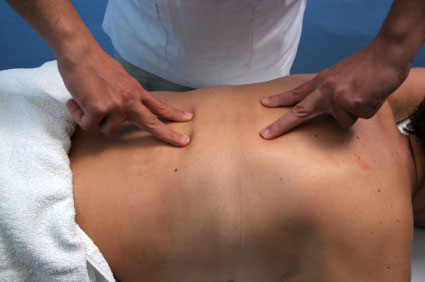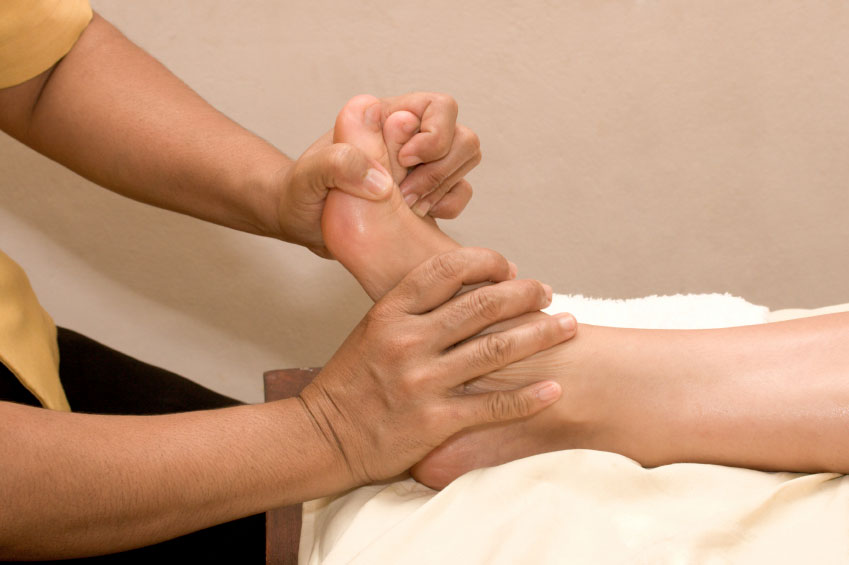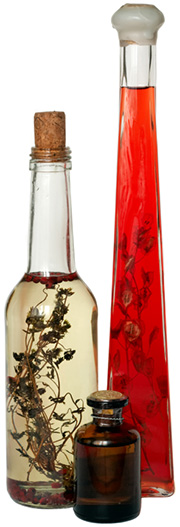Chinese Massage (Tui Na)
 Tui na (also known as tuina) is a branch of Oriental medicine that literally translates from the Chinese “zheng gu tui na,” meaning "to straighten the bone by pushing hand." It is an ancient form of Chinese massage and musculoskeletal manipulation involving the use of specific massage techniques to restore balance to the body.
Tui na (also known as tuina) is a branch of Oriental medicine that literally translates from the Chinese “zheng gu tui na,” meaning "to straighten the bone by pushing hand." It is an ancient form of Chinese massage and musculoskeletal manipulation involving the use of specific massage techniques to restore balance to the body.
Tui na is one of the 4 pillars of Oriental medicine, and as with all the pillars, tui na stimulates the body to naturally heal itself:
![]() Acupuncture
Acupuncture ![]() Chinese Herbalism & Nutrition
Chinese Herbalism & Nutrition ![]() Chinese Massage & Manipulation (Tui Na)
Chinese Massage & Manipulation (Tui Na) ![]() QiGong
QiGong
The tui na practiced in China today can be compared more to the work of chiropractors and physical therapists than to that of massage therapists. It is taught as a separate but equal field of study in schools of Oriental medicine, requiring the same level of training as acupuncturists and herbalists. A tui na practitioner is well-versed in the principles of Oriental medicine such as Yin/Yang, Qi, and the 5 elements. They undergo extensive education to master the theories and skills needed for clinical diagnosis and treatment.
Yin/Yang, Qi, & the 5 elements...
Although many of the techniques appear similar to western massage, a key difference is in the principles and philosophy behind the massage. Tui na practitioners work with the 20 blood vessels located throughout the body on 12 main pathways and 8 secondary pathways. Each main pathway is related to an organ or bodily function. There are various points along the blood vessels where the blood flow is closest to the surface of the skin, and these "acupoints" are stimulated using acupuncture, acupressure, and massage. By stimulating both the blood vessels and the acupoints, blood flow is stimulated. This increases the oxygen and nutrient flow throughout the body, which in turn increases the flow of vital energy.
Let's take a look at the various tui na techniques and how they differ from western massage techniques, and what you can expect during a typical session. We'll also look at what conditions tui na can effectively treat.
Tui Na Techniques
Unlike Swedish massage and other western massage techniques that are often used to promote relaxation and stress relief, tui na is a considered a therapeutic treatment. As tui na became more popularized in the west, the methods have been modified to become a more therapeutic extension of traditional western massage methods to address specific physical conditions. Most western-trained tui na practitioners do not practice bonesetting (realignment of joints and ligaments) as do their counterparts in China.
Tui na is very similar to shiatsu massage. As with shiatsu, it uses rhythmic compression along the body, as well as techniques that manipulate and lubricate the joints, including:
| Tui (pushing/pressing) Na (pulling/grasping Tao (strong pinching pressure) Nie (kneading) Nien (nipping/pinching) Moa (rubbing) An (rapid, rhythmic pressing) Rou (kneading) Dian (finger pressing) Ca (rubbing) Gun (rolling) Zhen (vibrating) |
Cuo (twisting/rubbing) Mo (wiping) Tina (lifting/grasping) Anrou (pressing/kneading) Boyun (forearm kneading) Ji (beating/drumming) Pai (tapping/patting) Dou (shaking) Yao (rotating) Ban (pulling) Bashen (extending) |
Tui na practitioners use the following techniques during treatment:
Massaging the 20 Vessels & Various Acupoints
This is the stimulation of blood vessels and acupoints to normalize the blood flow. As each acupoint is related to an organ of the body, many internal diseases can be addressed through their stimulation (e.g. hormonal disorders, respiratory disorders, and digestive problems, etc.). A tui na practitioner senses the client's body with their hands to determine where blockages exist and where blood flow is weak, depleted, or excessive.
Stretching the Body & Lubricating the Joints
This technique is used to stretch areas of the body and treats both acute and chronic pain associated with muscles, joints, and the skeletal system. It is especially effective for nerve pain, joint pain (such as arthritis), sciatica, muscle spasms, and pain in the back, neck, and shoulders. These techniques also helps with headaches (including migraines), and to relieve tension in the body associated with stress. Manipulation techniques (bonesetting) can also be used to realign the musculoskeletal system.
Applying External Aids
Sometimes, herbal poultices, compresses, liniments, and salves are used in addition to other techniques.
As with other branches of traditional Chinese medicine, tui na is used not only to correct problems, but also for preventative maintenance by ensuring a steady blood flow free that is free of blockages.
Tui na is suitable for use on the elderly, pregnant women, and infants. It is a natural and non-invasive therapy that has no side effects (except occasional soreness after a treatment). It can be used as a stand-alone treatment or used in conjunction with conventional medicine. Often, people who schedule tui na sessions have health problems that resist modern medical solutions, or that traditional doctors struggle to formally diagnose or recommend surgery for.
What Is A Tui Na Session Like?
Tui na massage takes place on either a table, floor pad, or mat. Loose clothing is worn and shoes are removed. Clothing should be comfortable, with top and pants/skirt as separate articles of clothing to allow the practitioner to easily reach various areas of the body. Occasionally, clothing may be removed to expose an area requiring direct skin contact.
 Conditions and health problems are discussed along with any current medications. The practitioner then conducts a physical examination of both the entire body and any specific conditions being treated. The major focus is on pain sites, acupoints, blood vessels, muscles, and joints. Some practitioners may also use Chinese herbs to facilitate quicker healing.
Conditions and health problems are discussed along with any current medications. The practitioner then conducts a physical examination of both the entire body and any specific conditions being treated. The major focus is on pain sites, acupoints, blood vessels, muscles, and joints. Some practitioners may also use Chinese herbs to facilitate quicker healing.
While performing tui na, the practitioner regulates their breathing and, using their hands, holds the intention to stimulate the flow of oxygen and vital energy in the blood vessels of the body. This helps release blockages and stimulates sluggish blood flow.
Treatment sessions range from 30 minutes to 1 hour. Depending on the nature of the problem, additional treatments are often needed. This is especially the case with chronic conditions. Tui na is not used on external wounds, on areas where there are malignant tumors, or on compound fractures. It should also not be performed on the abdominal area during pregnancy.
 Tui na is not considered light and relaxing. In fact, it can be very intense. Sometimes, a significant amount of pressure is required during massage and manipulation that can feel rigorous and uncomfortable. If there is excessive friction from rubbing or stroking, the practitioner may use talcum powder, sesame oil, or a specialized massage lotion or oil.
Tui na is not considered light and relaxing. In fact, it can be very intense. Sometimes, a significant amount of pressure is required during massage and manipulation that can feel rigorous and uncomfortable. If there is excessive friction from rubbing or stroking, the practitioner may use talcum powder, sesame oil, or a specialized massage lotion or oil.
Self-massage techniques may also be taught for practice at home in between sessions, and also for general well-being and preventative maintenance.
Clients should wait at least an hour to undergo treatment after eating a meal.
The costs of Tui na sessions vary according to both practitioner and location, averaging $50 to $100 in the US. Some practitioners offer discounts based on the number of sessions required. Many insurance companies now cover pain management therapies that include massage, chiropractic, and physical therapy. Some cover Oriental medicine, including all 4 pillars. Ask if your insurance company covers Chinese massage.
How Will I Feel After a Treatment?
After the treatment, a sense of calm and relaxation is often experienced, just like after traditional massage. Sometimes the experience is energizing, and sometimes an area may feel tender or sore. Slight bruising may occur at areas that experienced especially deep massage. Sometimes, there is an increased need to use the bathroom if the bladder and bowels are stimulated. Relief from pain may subside during the first session, although it may take several sessions to experienced noticeable and lasting results.
As with other forms of Chinese medicine, while being treated for one health problem, others may spontaneously begin resolving themselves. This is a very common and illustrates the beneficial effects of treatments that recognize all parts of the body are interconnected, and that focus on holistically bringing the entire body back into balance.
Choosing a Qualified Practitioner
Within the western world, Tui na is not regulated, however it is taught in schools that offer professional degrees in Oriental medicine. These programs ensure that students are knowledgeable about the principles and various branches of Oriental medicine.
Choosing a qualified practitioner...
Benefits of Tui Na
Tui na is considered safe for people of all ages, including children and the elderly. It is especially helpful in reducing the discomfort and managing various conditions related to aging. It is very effective in treating chronic pain associated with musculokeletal disorders including:
- Sports injuries
- Muscle spasms
- Joint pain (including arthritis)
- Sciatica
- Headaches and migraines
- Constipation
- Respiratory issues
- Circulation issues
- General fatigue
- Stress relief
RELATED ARTICLES
- Oriental medicine (Acupuncture, Chinese Herbalism, Tui Na, QiGong)
- Ayurveda
- Homeopathy
- Bach Flower Remedies



